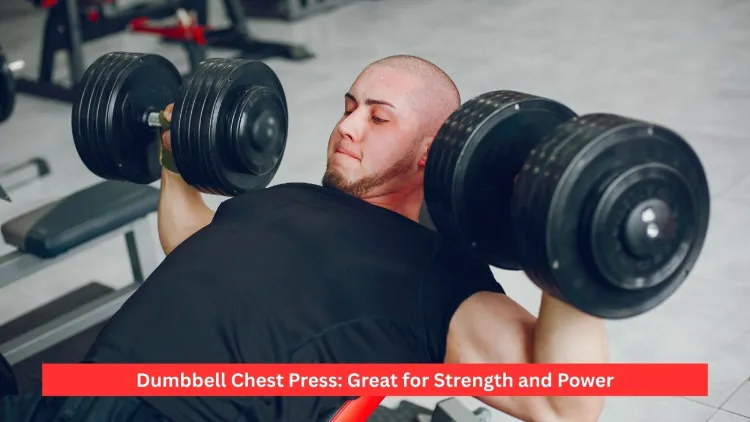Dumbbell chest press is an ideal strength exercise that builds muscle, improves the stability of the upper body, and improves posture. It works the chest, shoulders and triceps with the ability to move more than the barbell bench press. You may be aiming to add some muscle mass and increase strength, or you may be after defining your chest; either way, a correct form and angle on the dumbbell chest press can lead to great things. This guide elucidates the correct way of doing it, the favourable bench angles to grow the chest, the appropriate range of weights, and professional secrets on how to correct the mistakes and speed up the progress.
- What Is the Dumbbell Chest Press?
- Muscles Used in Dumbbell Chest Press
- Advantages of Dumbbell Chest Press
- Dumbbell Chest Press: How to Do It Right
- Common Mistakes to Avoid
- Variations of the Dumbbell Chest Press
- How to select the Right Bench Angle to Increase Chest.
- Selection of weight and training techniques
- Is it possible to build a big chest by using dumbbells alone?
- Dumbbell Chest Press vs Other Chest Presses
- Conclusion
- Frequently Asked Questions
What Is the Dumbbell Chest Press?
Dumbbell chest press is a traditional strength training exercise that builds up the upper body strength as well as muscle symmetry. It is the action of pressing the dumbbells upwards, starting at the level of the chest, when lying on a flat, incline, or decline bench. It also helps to enhance balance, coordination, and equal muscle development, unlike the barbell bench press, which uses both sides of the body, which are independent of each other.
The main muscles used in this exercise are the pectoralis major, which, however, makes use of the deltoids, triceps, and core stabilisers as well. The stabilising muscles of the joints are also increased because you can adjust two distinct weights, allowing you to have more control over your joints and have a more balanced muscle contraction.
The dumbbell press is, however, good on the chest, and to a person posing a question about whether it is a good exercise, I say resounding yes, it is among the best exercises which build up the chest and make the upper body appear defined.
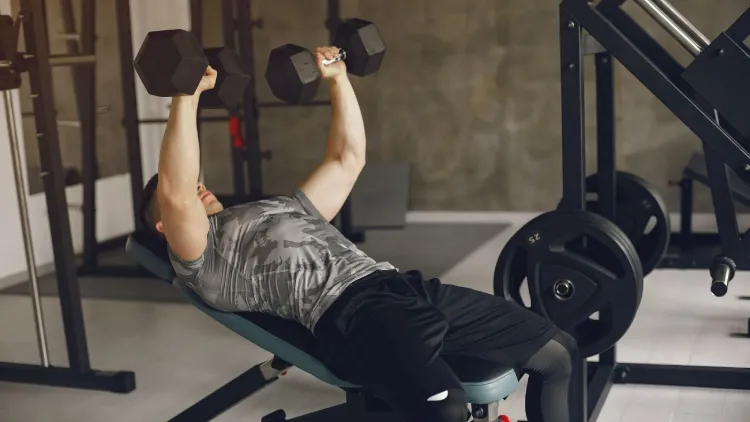
Muscles Used in Dumbbell Chest Press
In doing a dumbbell chest press, there are important muscle categories that must collaborate to enforce the weight and keep the weight down during the slow, gradual movement:
- Pectoralis Major – The primary muscle used, which presses dumbbells and creates a wide and powerful chest.
- Front Shoulders (Anterior deltoids) –You may assist the raising movement and stabilise the higher limbs.
- Triceps Brachii – This will help to push the dumbbells upwards, extending the elbows.
- Serratus Anterior and Core Muscles- Stabilise the body on the bench and regulate the movement.
This is a complete upper-body exercise, which makes the dumbbell chest press one of the most comprehensive and effective exercises in weight training.
Advantages of Dumbbell Chest Press
1. Improved Muscle Symmetry
Since the arms are independent of each other, the dumbbell chest press corrects muscular imbalance, which is commonly created by barbell pressing. It also makes both sides of the chest develop in a balanced manner, thus ensuring balanced strength and shape.
2. Enhanced Range of Motion
Dumbbells enable you to reduce the weights below those of a barbell and stretch your chest muscles to the maximum, hence other major muscles are more activated. The range supports flexibility and muscle development.
3. Better Joint Safety
During a dumbbell chest press, you may also flex your hand and elbow positions, which will ease the strain on the shoulders and naturally pressing motion, making it ideal for a dumbbell that lifters can push with sensitive shoulders.
4. Improved Functional Strength
The dumbbell chest press enhances pushing power, which is later transferred to normal daily tasks and sports involving the use of the upper body.
5. Better Stability and Co-ordination
Stabiliser muscles are tested by holding two dumbbells. This will eventually work on your coordination and will aid in avoiding injuries when performing your other compound lifts.
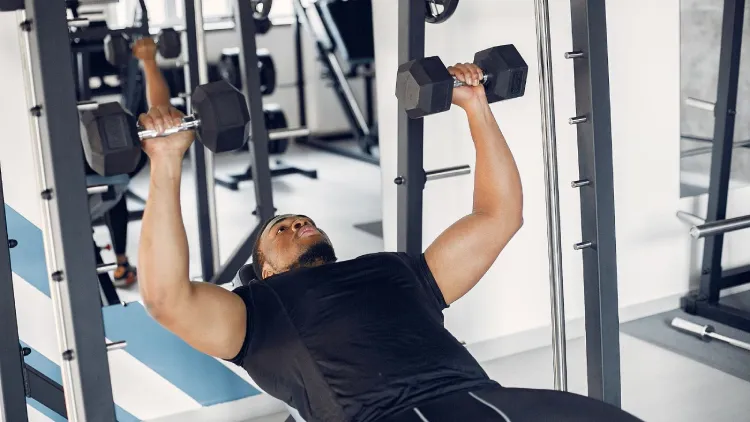
Dumbbell Chest Press: How to Do It Right
The dumbbell chest press is an important exercise that should be correctly performed to optimise muscle growth and prevent injury.
Setup:
- Lying on a bench with the grounding of the feet grounded.
- Grasp a dumbbell in both hands at the level of the shoulders, but facing in the direction of the palms.
- Arms should be straight, with the elbows a little lower than the shoulders.
Execution:
- Bring your core and lift the dumbbells until your arms are straightened and not bent.
- At the peak of the movement, squeeze your chest muscles.
- Gradually, bring down the dumbbells till your elbows are just under the line of the bench.
Breathing:
- Breathe in when reducing the weights.
- Exhale as you push them up.
Reps and Sets:
- To gain muscle (hypertrophy): 3-4 sets of 8-12 repetitions.
- For strength: 4–5 sets of 5–8 reps.
The optimal starting point for beginners is with a 10 kg dumbbell to learn form. When you make it through further, start adding weight slowly at a time, in the range of 60-70 per cent of your body weight per arm is a reasonable standard for aspiring lifters. To give an example, a 75 kg man can strive toward a weight of 4555 kg (2227kg per dumbbell) in terms of strength building.
In case you cannot touch your chest in the process, slow your speed, emphasise the tightening of your pecs at the top, and well, don’t let your elbows flare up too much.
Common Mistakes to Avoid
- Elbows Flaring Out – Have them facing at 45 degrees, or else shoulder injury will occur.
- Arching the Back Excessively –Keep in touch with the bench to support your spine.
- Uneven Pressing- Use both dumbbells simultaneously in the same direction so that there is a uniform supply of energy.
- Too Heavy Too Soon- Overloading at an early stage produces injury risks.
- Absence of Mind-Muscle Connection- Train to squeeze the chest, but not to move the weight.
In case you do not feel the pressure in your chest when using the dumbbells, it is better to take off some weight and focus on the slowest reps. Strength can also be built progressively using the 5-4-3-2-1 technique (five reps with the heaviest weight, four reps with slightly less weight, etc.) as well.
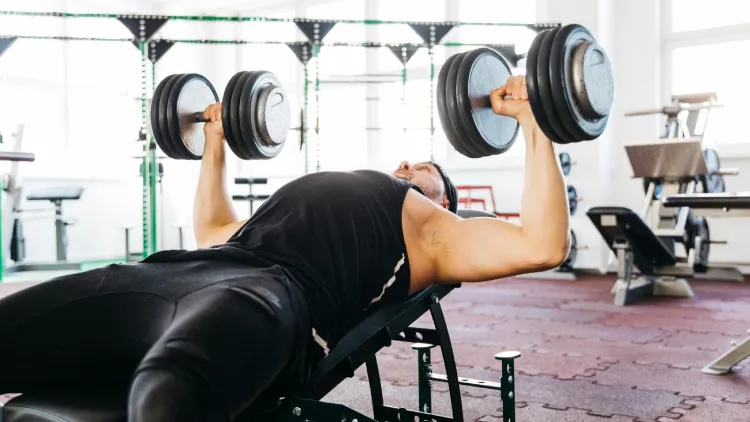
Variations of the Dumbbell Chest Press
This can be changed with a variant of the bench or grip, since it will change your focus to various parts of your chest and shoulders.
1. Incline Dumbbell Chest Press
This particular variation is performed at 30 o -45 o, which is aimed at the upper chest. The majority of the experts state that 30° is the best average level of growth, whereas 45 ° involves more shoulder growth.
2. Decline Dumbbell Chest Press
A minor drop is on the lower chest, something that contributes to making you appear round and fatter.
3. Neutral Grip Dumbbell Press
When holding the dumbbells, with palms together, one exerts less stress on the shoulders and focuses more on the triceps.
4. Single-Arm Dumbbell Press
Such one-sided action enhances stability and stability of the core as well as even development of muscles.
5. Floor Dumbbell Press
Restricts the movement to take care of the shoulders but keeps the chest active – good to start with or in shoulder injury re-imagery.
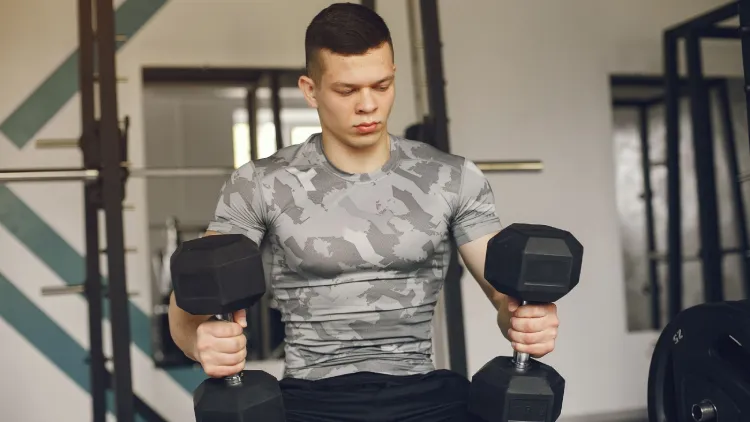
How to select the Right Bench Angle to Increase Chest.
In relation to the optimal dumbbell chest press angle, 30-degree incline is, as a rule, used as the optimum angle to achieve growth in the upper chest. Shoulder involvement is more active at 45 degrees, making the accent reduced in emphasis on the pectorals. The tradeoff between the flat and the 30-degree incline gives an equal development to most of the lifters.
Shoulder presses are better with angles above 60 degrees, whilst the flat bench is ideal for building up the entire chest.
Selection of weight and training techniques
To gain muscle, get dumbbells that make your muscles tired, 8-12 reps, and still have good form. A dumbbell weighing 10-20 kg suffices in the case of beginners, and extremely advanced lifters can exceed 30 kg per hand.
This is enhanced by the 2-2-2 rule (two seconds up, two seconds hold, two seconds down), which better controllability and engages the muscle. Likewise, the 3-to-7 training system will build up strength and endurance over reps in moderate weights.
The development of muscle relies on progressive overload — raising the resistance over time. It is important to be consistent and in good form, whether you want hypertrophy or power.
Is it possible to build a big chest by using dumbbells alone?
Yes, you absolutely can. Dumbbell chest press, when done in combination with dumbbell flyes, push-ups and dumbbell incline press, can fully build up your chest without the use of a barbell. It is all about consistency, correct nutrition and rest.
Most of your outcomes are determined by effort, form and progressive overload, even when some of the strength is inherited.
Dumbbell Chest Press vs Other Chest Presses
Although barbell and machine presses may have advantages, the dumbbell chest press has better results in muscle involvement, freedom of movement and also balance. A combination of the barbell and dumbbell exercises is the most effective for most lifters.
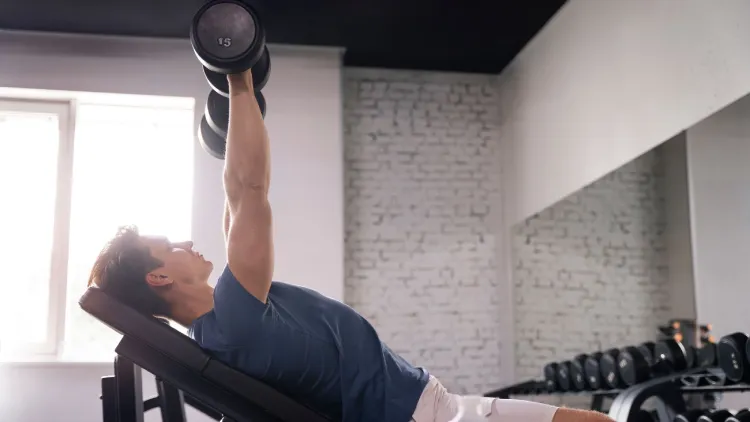
Conclusion
Dumbbell chest press is considered one of the best exercises to gain size, symmetry, and strength of the upper body. It engages various body muscles, enhances the stability of the joints and assists in balancing body muscles. It can be done flat or at 30 inclination; however, both provide similar outcomes to chest growth.
With the right shape, choice of the correct weights and playing with angles, you can revolutionise your upper part of the body and get a strong and well-built chest. The main thing is to be patient, progress, and be constant – one rep will take you closer to a better version of yourself.
Frequently Asked Questions
1. Can I develop my chest using only dumbbells?
Yes. Dumbbell chest press and its variations are an effective workout as they train all the parts of the chest, and you only need dumbbells to become big and strong.
2. Which angle is optimum for making the upper chest grow?
The dumbbell chest press works best on a 30-degree tilt, which will work the upper part of the chest and will have fewer demands on the shoulders.
3. Why don’t I feel my chest when doing the dumbbell press?
Slow controlled reps, maintain 45-degree angle of the elbow and squeeze the chest at the top to enhance activation.
4. What is the recommended weight to use on the dumbbell chest press?
Novices may start with 8-10kg of dumbbells, whereas more advanced lifters may do them with heavier weights but with fewer reps of 8-12.

